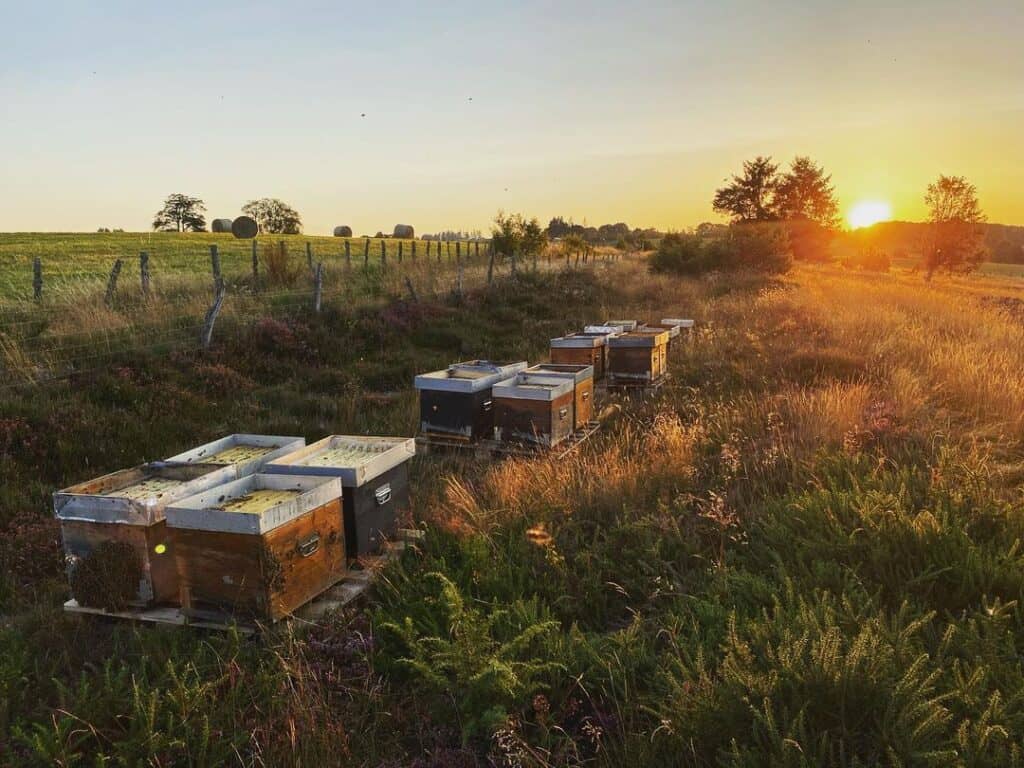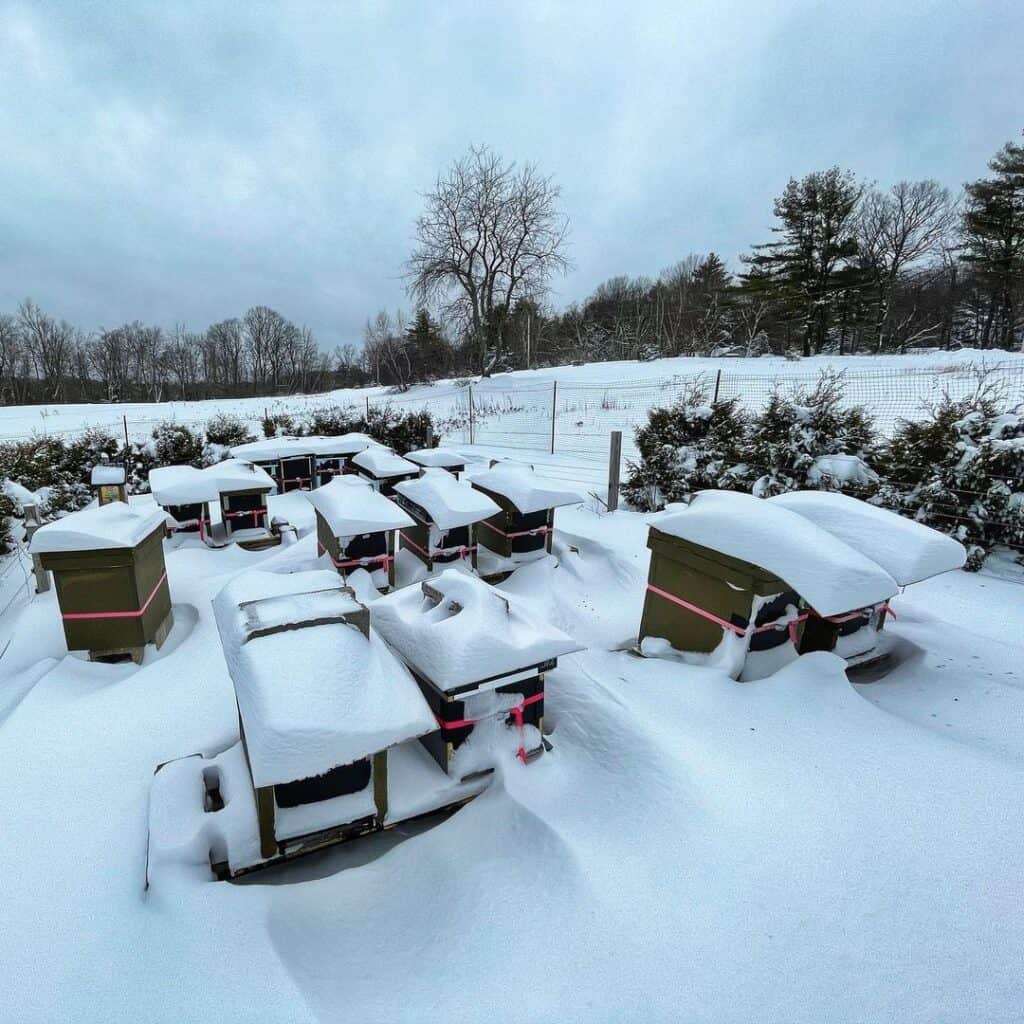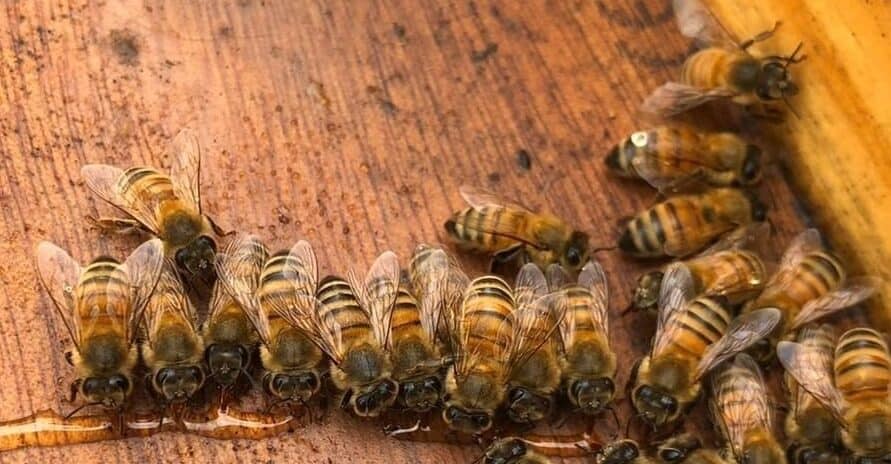Bees are heterothermic animals, but with a pronounced tendency to be warm-blooded, which is especially noticeable when they form clusters. Bees become essentially warm-blooded during periods of activity, but when they are inactive, their temperature is balanced by ambient temperature.
Brief answers to the most popular temperature questions for bees:
| What temperature do bees come out? | The bees go outside when the air temperature is above 50-55°F. |
| At what temperature do bees die? | The bee dies at temperatures above 113°F or below 28°F. |
| What temperature do bees stop flying? | Usually, honey bees stop flying at temperatures below 50°F. |
| What temperature is too hot for bees? | Wild bees could tolerate temperatures of 122°F, while domesticated bees could only survive and work to 108°F. |
| What temperature is too cold for bees? | A domesticated bee begins to stiffen at 55°F if it does not move. |
| At what temperature do bees become inactive? | Bees become inactive outside the 50-110°F air temperature range. |
| What temperature do bees like? | The greatest activity of honeybees was observed at 68 °F. |

What temperature do bees keep in their hive?
Heat receptors located on bee antennae allow the measurement of ambient temperature to an accuracy of 0.2°C (Heran 1952, Lacher 1964, Yokohari 1983). The molecular receptor channel, which is most likely of major importance in temperature measurement, is located in the flagella of the bee’s antennae. It is activated at 93°F. Honeybees cope with the adverse effects of high temperatures through the presence of cuticles and fat on the body surface, which they store before excessive water evaporation.
The temperature maintained by bees in the hive usually ranges between 91 and 97°F, and the optimal temperature for proper brood development is 93°F. Pupae are very sensitive to temperature fluctuations. Bees regulate the temperature in the hive. When the temperature exceeds 97°F, the worker bees begin to air the hive, positioning themselves at the entrance with their head inside the hive, and vibrating their wings to move the air to cool the middle of the hive.
Bees also lower the temperature in the hive by evaporating water. The worker bees spray droplets on the walls of the hive and on the edges of the honeycomb with brood. This prevents the developing larvae from drying out and also lowers the temperature. Bees retain a thin layer of water on the surface of their mouthparts-its evaporation also helps cool the environment.
If the air in the hive overheats, the workers leave the hive and form a ball when they enter the hive. At this time, some of the bees continue to ventilate the honeycomb and splash water. Another interesting mechanism of thermoregulation is shielding, which was observed by Starkow and Gillie in 1999. Bees keep the honeycomb with supplies and brood from overheating by sitting on the hot inner walls of the hive and creating an insulating layer of their bodies.
If the temperature in the hive drops below 91°F, the bees must warm the air. This usually occurs by compaction in the hive. This behavior is best seen when observing wintering bees that form a winter ball. They keep it at a constant optimum temperature of 65 to 68°F in fall and winter and around 93°F at the beginning of the season when brood is starting to develop. During wintering, the temperature of the outer layer of the hutch is about 54 to 59°F. At the end of January, bees begin to prepare for the new season. The temperature in the middle of the ball rises to 93,2°F, which stimulates the queen to lay eggs.

What temperature do bees go dormant?
Bees do not dormant and continue to live normal lives in their hives. In winter, bees’ metabolism slows down, so they consume little food and live longer than their summer counterparts.
In the fall, bees cover all the cracks in the hive with propolis. They make the entrance to the hive very narrow to keep out bad weather and precipitation. When the temperature drops to 43-46°F, one bee can not warm itself, so they gather in a “ball” – a spherical mass in which bees touch each other and warm themselves. The bees swap places, the frozen ones make their way to the middle, where it is warmer, and the warmed bees move to the edge. Depending on the ambient temperature, the ” ball” may expand or thicken.
Humidity and temperature in beehive
The relative humidity (RH) prevailing in the nest is another very important factor affecting brood development and the condition of the adult bees. It has a direct effect on moisture retention in bee bodies: the lower the RH, the greater the water loss.
Zhiyong Li’s group proved in 2016 that relative humidity is mainly regulated by female workers. This parameter is very important for proper egg development. Relative humidity below 50% prevents larvae from hatching, while the optimal humidity is between 90 and 95%. Relative humidity above or below the optimum significantly reduces the number of hatchable larvae.
If the relative humidity is too low, bees begin to take preventive measures: they increase water evaporation from nectar and honey. If the relative humidity is too high, the workers dry the air by increasing ventilation. It is worth noting that scientists suggest that when growing larvae in vitro, the temperature should be kept at 34°C and the relative humidity at 90%.
What temperature to inspect bees?
When the air warms up to 46-50°F, you can open the hive briefly and make an inspection. The first thing to do is to assess the food supply and the presence of the queen in the family. If the brood is seen, there is no need to worry about the presence of the queen.
What temperature kills bees?
Bees can be killed by temperatures above 113°F or below 28°F.
